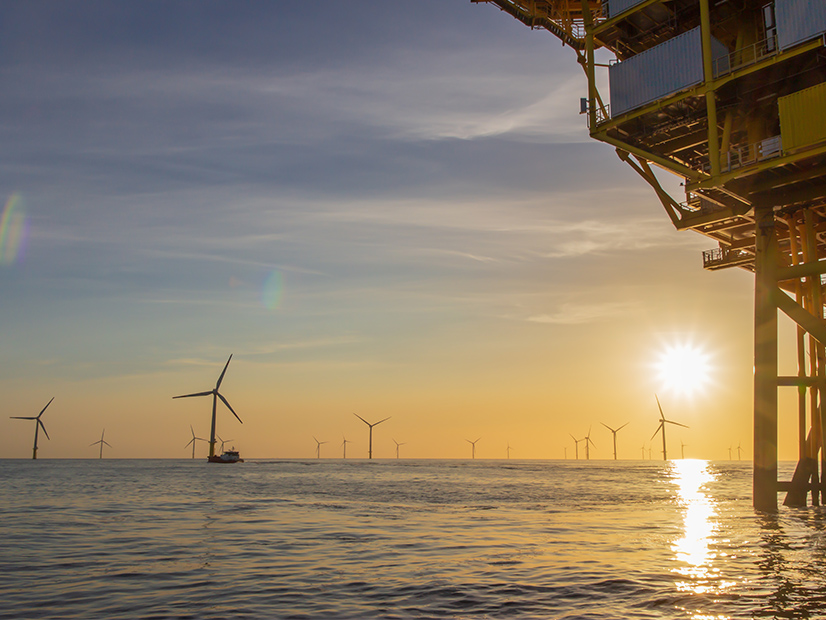The New Jersey county of Cape May asked the state Board of Public Utilities (BPU) on Thursday to slow the approval process for an easement to run power cables from the state’s first offshore wind project — Ocean Wind 1 — across county land until federal environmental studies are completed.
 Michael J. Donahue, representing Cape May County | New Jersey Board of Public Utilities
Michael J. Donahue, representing Cape May County | New Jersey Board of Public Utilities
Michael J. Donahue, a lawyer and former state superior court judge representing the county at two online BPU hearings, said the federal environmental impact study could provide information that is relevant to whether the cable route is feasible or not.
Donahue, who said he also represents 10 of the 16 communities in Cape May County, also urged the BPU to consider alternative routes more acceptable to area residents, many of whom oppose the project.
Danish developer Ørsted is seeking BPU approval for an easement to run cables bringing energy from its Ocean Wind project to a substation that would tie the project to the grid. The developer’s favored route runs through the Jersey shore community of Ocean City, which is in Cape May County.
The case is related to but separate from Ørsted’s petition for an easement running across public land in Ocean City, which the BPU approved on Wednesday. (See NJ BPU Approves Easement Plan for 1st OSW Project.)
Ørsted’s second petition also seeks BPU consent for the developer to obtain several environmental and other permits needed to get project approval from the New Jersey Department of Environmental Protection (DEP).
The case is the second test of a controversial law (S3926) enacted in July 2021 that allows offshore wind developers to site power cables and equipment on public land regardless of local or state government opposition. If the BPU backs the easement and consents, the developer would not need approval from the county or Ocean City, which also opposes the project.
“The county is not trying to delay or obstruct,” Donahue told the hearing. “But we think it’s important that many of the issues that concern the people of Cape May County be given an opportunity to be heard.”
Donahue said the county had had “discussions over a long period of time” with Ørsted about the project, including an attempt to “modify the impacts, especially in terms of cluttering the horizon.” But the two sides failed to reach an agreement, he said.
“We urge the board, as Ocean City has, to wait for those federal environmental processes to be completed so we don’t have the prospect of having to do all this all over again,” Donahue said. The proposed route could jeopardize sensitive marshes and impact area historical sites, he argued, and it could “conflict with many utilities that already exist” in the area, including sewer, gas and water main lines.
Negative Impact
The 1,100-MW Ocean Wind project, which the BPU approved in 2019, was the first of three offshore wind farms approved by the state to date. The BPU expects to follow the approval of the 1,148-MW Ocean Wind 2 and the 1,510-MW Atlantic Shores in 2021 with a third solicitation for 1,200 MW in the first quarter of 2023. (See NJ Seeks Stakeholder Input for 3rd OSW Solicitation.)
The projects are part of Gov. Phil Murphy’s goal, signed on Sept. 21, that the state have in place 11 GW of offshore wind capacity by 2040. That goal replaced Murphy’s earlier goal of 7.5 GW by 2035.
The Bureau of Ocean Energy Management issued a draft environmental impact statement (EIS) on Ocean Wind 1 on June 22, with comments due by Aug. 23. The draft found that the project would not have major impacts on most of the 19 environmental and related categories scrutinized.
But the 1,408-page report did find that the construction and installation, operations and maintenance, and eventual decommissioning of the project would have major impacts on marine navigation and vessel traffic, as well as commercial and recreational fishing. (See BOEM Draft EIS Finds Potential Major Impacts from 1st NJ OSW Project.)
BOEM held three public hearings on the draft in July. The agency said that after it “addresses the comments provided,” it will issue a final EIS that will “inform” its decision to “approve, approve with modifications or disapprove the project.”
But federal approval is only one hurdle for Ocean Wind 1. Ørsted is seeking a 30-foot-wide easement running about eight miles along the length of Ocean City, a popular tourism and vacation area on the Jersey shore. The 275-kV line will connect the project’s turbines, about 15 miles offshore, to the PJM grid at a substation sited on a now closed coal-fired power plant in neighboring Upper Township.
At issue in the Cape May case is the project’s need for a temporary 18-month easement and a 30-foot-wide permanent easement across county land, both in Ocean City, the developer’s May 20 petition says.
The BPU’s approval of the Ocean City easement on Wednesday was a big step forward for Ocean Wind 1, allowing project cables to pass across land in Ocean City created with funds from the state Green Acres program, which pays to improve parkland and open space.
The case, which involves the same cable route as the Cape May County case, was the first test of the law granting the BPU power to override local officials on issues involving offshore wind projects. The law allows the BPU to do so — and grant approvals on projects — if the agency concludes that they are “reasonably necessary” to the project.
 Madeline Urbish, Ørsted’s head of government affairs | New Jersey Board of Public Utilities
Madeline Urbish, Ørsted’s head of government affairs | New Jersey Board of Public Utilities
As in the earlier case, Ørsted argued that they are. Madeline Urbish, the company’s head of government affairs, told the hearing that the project needed the BPU’s approval to move ahead and meet New Jersey’s clean energy goals, after the developer had held fruitless discussions with Cape May County since 2019.
“Time is of the essence if the project is going to meet its commitment to New Jersey” and reach commercial operation in 2024, Urbish said.
“Cape May County has not been willing to reach the necessary agreements to allow the project to proceed,” she said. The county’s approval and permit consents are required for the project to secure approval from the DEP, whose blessing is needed in turn for the environmental review conducted by the federal Bureau of Ocean Energy Management.
Alternative Route
Donahue countered that in order to limit disruption and negative impacts from the transmission lines, the BPU should consider cable routes for two other offshore wind projects approved by the agency — Ocean Wind 2 and Atlantic Shores — at the same time as the route and easements for Ocean Wind 1.
Instead of running the cables through Ocean City, Ørsted could send them along an abandoned railroad or part of the Garden State Parkway, the main highway along the Jersey shore, he said.
More than a dozen speakers at the two hearings on Thursday opposed either the granting of the easement or the project in general. Many said they are Ocean City residents, and some were clearly upset by the BPU’s intervention in what they considered a decision that should be taken by local officials.
 Ocean City’s business administrator, George Savastano | New Jersey Board of Public Utilities
Ocean City’s business administrator, George Savastano | New Jersey Board of Public Utilities
George Savastano, Ocean City’s business administrator, questioned the legitimacy of the law and the “authority” of the BPU to make decisions on the easement issue. “It remains to be seen whether it will survive judicial scrutiny,” he said of the law, citing a section of the state constitution that, he said, states “any law concerning municipal corporations formed for local government or concerning county shall be liberally construed in their favor.”
Savastano also argued that Ørsted’s designation of several alternative routes for the cable means that the chosen route through Ocean City is not “reasonably necessary.” That question is enough reason for the issue to be heard by an administrative law court, rather than the BPU, he said, and urged the agency to send the case to the court.
At a hearing on the first easement case in June, Ocean City called on Ørsted to choose a route that would avoid the municipality and instead send the cable through Great Egg Harbor Bay, coming on shore close to the substation in Upper Township and avoiding Ocean City altogether. Cape May County also supports that route.
Savastano said that the route through Ocean City is shorter, and so likely cheaper for the developer, who should, as a result, be required to divulge the cost of pursuing each of the available routes.
“Until and unless Ocean Wind discloses the cost of each of the alternate routes, the board cannot find that the easements and consents which Ocean Wind claims to need are reasonably necessary,” he said.
The BPU has said in the past that the cost of any of the routes is irrelevant to the discussion because it will be paid for by Ørsted and won’t be an expenditure of public money.

